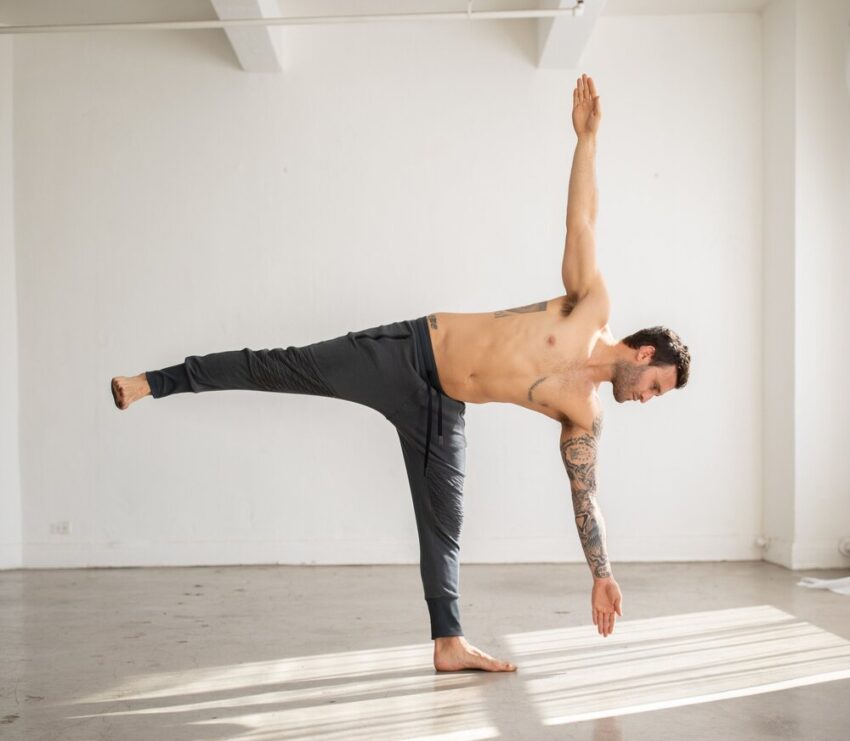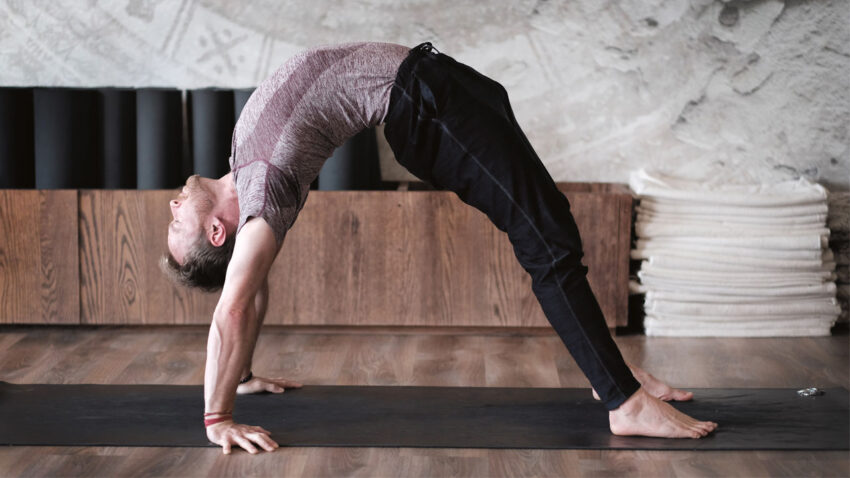Half moon pose is the ultimate arm balancing pose. It requires the practitioner to be very aware of the alignment of the spine while focusing on the low back and hamstrings. The half moon pose is an advanced yoga pose that helps to strengthen the core muscles, improve posture, and relieve stress.
Unlike the wide-leg pose, the half-moon pose requires the practitioner to be balanced and in control with the weight on one leg while lifting the other leg behind the body. Not only does it help reduce back strain, but it also helps to create stronger hip muscles, reduce lower back pain, and open the chest and back. The half-moon pose can be done by practitioners of all skill levels as long as they are able to remain balanced without slouching forward or rotating their pelvis.
What Is Half Moon Pose?

Half Moon pose is a standing balance pose that is often needed after a triangle or extended side angle pose. This pose requires you to have one side of the body making contact with the floor while the arms and legs are outstretched.
Preparatory poses for half moon pose include sun salutation, uttita trikonasana (extended triangle pose), parsvottanasana (intense side stretch pose), virabhadrasana I (warrior pose I), triangle pose, warrior pose III, warrior pose II, extended side angle pose, reverse warrior pose.
In the sequence above, you will practice the poses in the right order to develop the strength and flexibility needed for the final posture.
You should be able to perform the stretches with ease before attempting the pose and follow the right steps to achieve it successfully.
How To Execute the Half-Moon Pose
The Half Moon pose requires you to start in Utthita Trikonasana (Extended Triangle) and bend your front leg while shifting your weight into your front foot. Reach your front hand forward towards the mat or a block beneath your front shoulder and press down as you lift your back leg until your thigh is parallel to the floor. Then, turn your chest to the right, twisting your torso and hips, reaching your top hand toward the ceiling, and looking at the floor or top hand. To exit the pose, return to Extended Triangle in the same way you came into it. The Half Moon pose is an excellent posture for building balance and flexibility in the body. It also tones the arms, chest, back, and legs. Plus, it’s a great pose for beginners to practice yoga poses.
Benefits of Half-Moon Pose
– Half Moon pose is a yoga pose where you balance the body on the left leg, right leg, left arm, and right arm in the shape of a half moon shape.
– This posture strengthens the core and legs and opens the hips and chest. It helps improve balance and coordination.
– Increases flexibility in the spine, hips, and legs.
– It can help to reduce stress and tension in the body.
– Finally, it can help to relieve lower back pain, sciatica, and neck pain.
Surya Namaskar (Sun Salutation) is a series of yoga poses that are practiced for improving balance, coordination, flexibility, strength, and stamina. Sun Salutations are practiced to increase the blood flow to the body’s organs as well as to the brain. Surya Namaskar also improves overall body health by increasing the body’s metabolism rate and helping it to become stronger. This posture strengthens the abdomen and back muscles as well as stretches them. It also tones the glutes, hamstrings, hip flexors, calves, ankles, wrists, forearms, shoulders, chest muscles, back muscles (latissimus dorsi), and abdominals (obliques).
In addition to all these benefits, there is also the emotional aspect of Sun Salutations which is known as ‘communing with nature’. You can feel relaxed while doing this posture as it helps boost your confidence level. Moreover, you will also be able to concentrate better after doing a half-moon pose for some time.
Tips to Master the Half-Moon Pose
– Be aware of the key elements of the pose and how to perform the pose correctly.
– Start with a wide-legged stance and bend your left leg knee towards the floor.
– Bend the left arm toward the left leg, bend the right arm back, and reach up with the left hand.
– Keep the left hand in the fingertips position for balance and support.
– Slowly look forward and inhale as you lengthen your body forward.
– Slowly exhale as you bend back to come back to the standing pose.
– Try practicing preparatory poses like Surya Namaskar (Sun Salutation), Utthita Trikonasana (Extended Triangle Pose), Parsvottanasana (Intense Side Stretch Pose), and Virabhadrasana I (Warrior Pose I) before attempting Half Moon Pose. This will help increase stability in the pose and prepare you for more difficult poses.
– Practice the pose frequently and gradually increase your difficulty level each time you practice it. Be patient and consistent with your practice, and you can gradually gain proficiency in the pose.
Try the Half Moon Pose Today!
The Half Moon pose is a popular yoga posture that requires core balance, length, and strength. It is a balancing pose that strengthens the torso and abdomen. The sequence of the pose starts with a down-facing dog pose. From there, the balancing pose, the moon pose, is followed by the warrior pose.
The balance pose builds arm and leg strength. After the balancing pose, the poses for stretching the back are performed. One knee extends straight behind with the bottom shin extended straight forward and the other leg extended out to the side parallel to the floor. This leg stretcher is also known as the crescent moon pose or half moon pose. When practicing the half-moon pose, it may be beneficial from having a block on hand for extra support.
By practicing the Half Moon pose in a sequence and incorporating the poses into your yoga routine, you can strengthen your body and mind.
Conclusion
Half moon pose helps strengthen the core muscles, the hamstrings, and the back muscles. It also strengthens the abdominal wall muscles and the front torso muscles. Practicing it will help improve your posture and flexibility, as well as lower back pain. Comment below if we have left out any other half-moon pose benefits that you think would help others!
If you to read more click here








